The AI chatbot industry is bursting with innovation, offering diverse tools and solutions. While ChatGPT has undoubtedly earned its place as a frontrunner, many compelling alternatives have emerged, each with unique strengths and capabilities. Let’s explore the world of ChatGPT alternatives and why choosing the right tool is crucial for your needs.
Introduction to ChatGPT Alternatives
Overview of AI chatbots
The world of AI chatbots is bursting with innovation, offering diverse tools and solutions. While ChatGPT has undoubtedly earned its place as a frontrunner, many compelling alternatives have emerged, each with unique strengths and capabilities. Let’s delve into the world of AI chatbots and explore why choosing the right tool is crucial for your specific needs.
The Need for Diverse AI Chatbot Solutions.
Just as every individual has unique communication styles and preferences, the landscape of AI chatbots offers diverse options to cater to specific requirements. While some chatbots excel at providing quick and informative answers, others are better suited for creative writing or generating different kinds of creative text formats.
The growing demand for AI-powered solutions has led to a surge in chatbot development, providing users with a broader range of choices than ever before. Worldwide retail spending on chatbots will rocket from $12 billion in 2023 to $72 billion by 2028. This diversity is essential because it allows users to select the chatbot that aligns perfectly with their goals and expectations
Importance of choosing the right AI chatbot tool
The right AI chatbot tool is crucial for maximizing efficiency and achieving desired outcomes. Factors such as industry, target audience, budget, and specific use cases should all be carefully considered. For example, a business seeking to automate customer service inquiries would require a chatbot with robust NLP capabilities and a vast knowledge base. In contrast, a tech-development company may prefer an advanced AI like GitHub Copilot. By understanding your needs and exploring the available options, you can select the AI chatbot that empowers you to communicate effectively and achieve your goals.
ChatGPT – Pros, Cons, Key Features & Use Cases
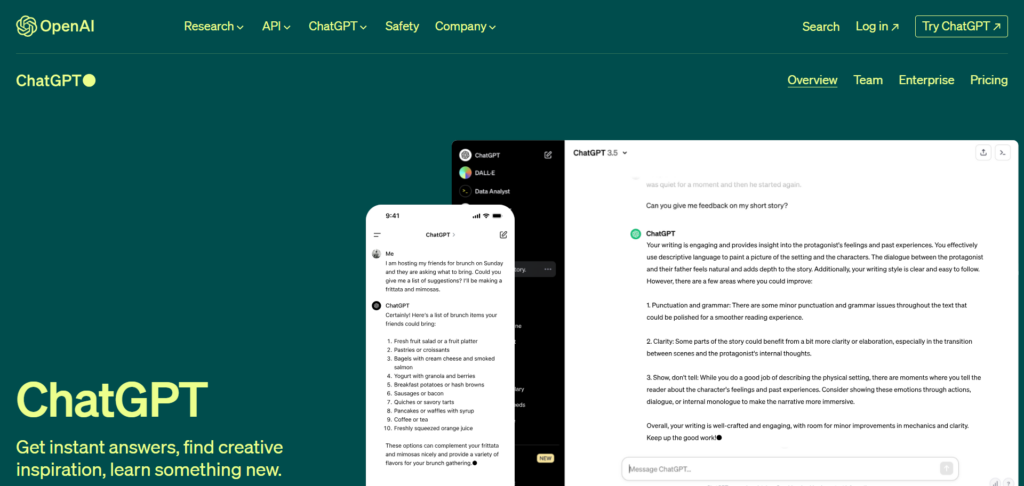
ChatGPT has emerged as a versatile tool capable of engaging in human-like conversations and tackling various language-based tasks. Let’s dive into the ChatGPT details, exploring its core functionalities, strengths, limitations, and potential applications.
What is ChatGPT?
ChatGPT, developed by OpenAI, is a cutting-edge AI chatbot built upon a large language model, specifically GPT-3.5 or GPT-4. Its ability to process and generate natural language makes it an impressive communication and content-creation tool. Imagine having a virtual assistant who can understand your requests and respond with coherent, contextually relevant text – that’s the essence of ChatGPT. Launched on November 30, 2022, it quickly gained traction due to its remarkable capabilities.
It’s worth noting that while basic usage of ChatGPT is free, a premium version with advanced features caters to users seeking more substantial engagement.
ChatGPT Key Features and Benefits
ChatGPT boasts a diverse array of features that cater to various user needs. Let’s explore some of its key strengths:
- Human-like Text Generation: ChatGPT excels in producing human-like text based on previous inputs thanks to mastering NLP technology.
- Diverse Utility: From writing articles and emails to generating programs or completing sentences, you command; it delivers!
- Continual Learning: ChatGPT can continually learn and improve from interactions, enhancing its responses and accuracy over time and becoming more effective at understanding and responding to user queries.
- Multilingual Support: The chatbot supports multiple languages and is set to expand this feature, allowing it to break down language barriers and facilitate communication for a global audience1.
- Emotion Detection: ChatGPT can detect the user’s emotional state and tailor its responses accordingly, providing a more engaging and empathetic interaction experience.
- Creative Writing and Tutoring: It assists with creative writing by generating ideas and providing feedback, and it can also serve as a tutor by answering questions on various subjects in a clear and concise manner1.
- Role-Playing: ChatGPT can engage in role-playing conversations, assuming different personas based on user input, which is beneficial for those looking to practice conversational skills or enjoy role-playing games
- Language Translation: ChatGPT can translate text between multiple languages, breaking down language barriers and facilitating communication across diverse audiences.
- Code Generation: ChatGPT assists programmers by generating code snippets in various programming languages, streamlining the development process.
- Text Summarization: ChatGPT can condense lengthy texts into concise summaries by simplifying complex information, saving time and effort.
ChatGPT Use Cases
The efficient design of ChatGPT suits various use cases across disciplines:
- Customer Service and Support: ChatGPT can be integrated into customer service platforms to automate responses to common queries, improving response times and customer satisfaction by providing instant, human-like assistance.
- Content Creation and Curation: It assists in generating human-like content such as articles, blogs, and social media posts, helping businesses maintain an active online presence and engage with their audience more effectively.
- Recruitment and Hiring: ChatGPT streamlines the recruitment process by screening resumes and conducting initial interviews, saving HR teams significant time and effort while ensuring a more efficient candidate selection process.
- Legal and Compliance: Legal teams can utilize ChatGPT to analyze contracts, legal documents, and regulations, ensuring that organizations remain compliant with evolving laws and regulations, especially when entering new markets.
- Education and Tutoring: ChatGPT serves as a virtual tutor, providing personalized learning assistance, language tutoring, and generating educational content, making it a valuable tool for students and educators.
- Entertainment: ChatGPT can be used for creative writing, storytelling, and even generating personalized jokes or poems.
ChatGPT Pros and Cons
| Pros | Cons |
|---|---|
| Efficiency and Scalability | Lack of Emotional Intelligence |
| Enhanced Human-Like Text Generation | Inaccuracies and Ambiguities |
| AI-Powered Creative Writing Coach | Limited Control Over Generated Content |
| Multilingual Support and Translation | Spreading Misinformation |
| Customizable User Interface | Privacy and Security Concerns |
| Improves Content Quality | Biased Responses |
| Personalizes Learning | Limited Knowledge |
Despite its superior abilities, ChatGPT isn’t without flaws:
- Limited Knowledge: ChatGPT is trained on data only up to a certain point, which means it lacks information on recent developments and cannot provide insights on events or changes after its last training cut-off.
- Potential for Biased Responses: The AI is trained on large datasets that may contain inherent biases, leading to responses that could unintentionally perpetuate these biases or prejudices.
- Difficulty Understanding Context: ChatGPT can struggle with context, particularly with nuances such as sarcasm or humor, resulting in responses that miss the intended meaning or are inappropriate for the situation.
- Accuracy and Grammatical Issues: The model may produce responses that are not entirely accurate in terms of context or content. It is also limited in sensitivity to typos, grammatical errors, and misspellings, which can be problematic when precision is required.
- Creativity Limitations: While ChatGPT can generate creative content, it may lack the originality and depth of human-generated work.
While ChatGPT presents a robust solution for textual digital interaction, its limitations push us to explore equally potent or better alternatives. This exploration would help users balance their unique requirements and what these AI chatbots offer.
Best ChatGPT Alternatives and ChatGPT Competitors
The landscape of AI chatbots is constantly evolving, with new and improved options emerging regularly. While ChatGPT has undoubtedly been a pioneer in this field, a diverse range of best ChatGPT alternatives have stepped up to offer unique features and capabilities. This growing ChatGPT competition empowers users to choose the AI chatbot that aligns perfectly with their needs and preferences.
Exploring the competitors to ChatGPT opens doors to enhanced creativity, improved efficiency, and a more tailored AI experience. Whether you’re a content creator, developer, or AI enthusiast, understanding the strengths and weaknesses of each alternative is crucial. Let’s dive into the world of ChatGPT alternatives and discover the perfect AI companion for your endeavors.
SEOwind – Best AI Article Writing ChatGPT Alternative
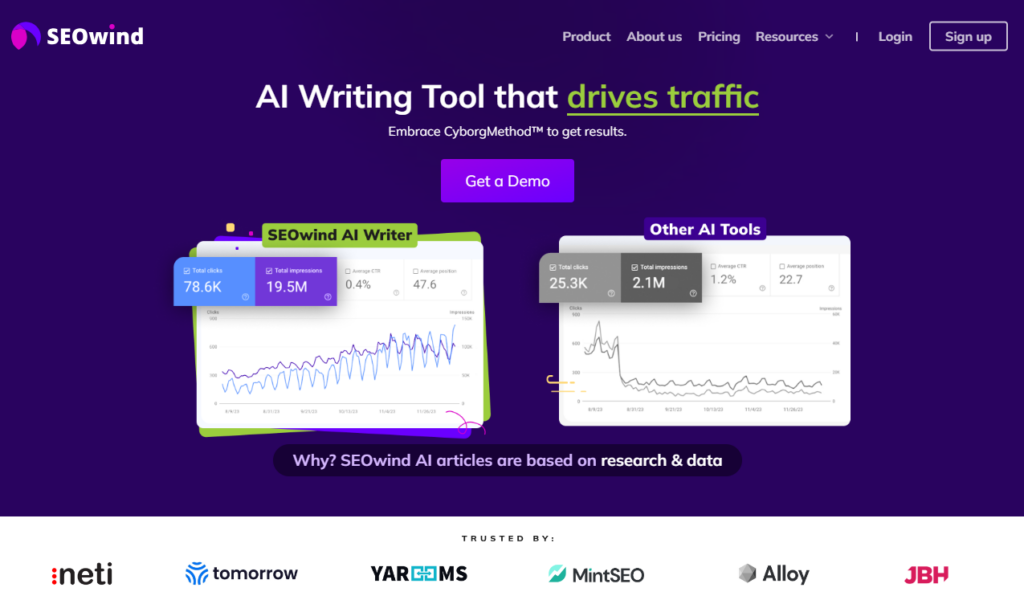
If you’re in the market for an efficient tool that takes writing to a new level, SEOwind could be worth serious consideration. Offering advanced capabilities and features akin to a powerful search engine coupled with savvy content creation capabilities, it is one of the better alternatives to ChatGPT for content writing.
SEOwind Key Features & Benefits
SEOwind boasts a suite of features designed to elevate your content creation process:
- AI Outlines: SEOwind can generate automated outlines driven by vast amounts of SEO data, facilitating a superior alignment with your audience’s search intent.
- SEO Research: Offering an in-depth examination of top-ranked pages, including their meta-tags, word counts, and keywords used–ensuring your craft aligns effectively with current trends.
- Brand Voice Alignment: It can tailor-fit its output to embody the tone of your brand voice, providing consistency across all written content.
- Stats and Quotes Integration: This feature enhances article authority by inserting relevant statistics and insightful quotes relating to your subject matter.
- Your insights: Infuse your articles with your unique expertise and knowledge, making them more original and authentic.
- Customizability: Granting creative control over AI outlines and allowing customization based on what ranks is a valuable asset ensuring user-friendliness.
- In-built prompts: SEOwind utilizes extensive prompts to guide the AI, ensuring high-quality output that aligns with your goals.
- GSC Integration: Leverage the power of Google Search Console integration for internal linking and content gap analysis.
Furthermore, SEOwind can support 12 languages, facilitating reaching out to wider audiences in their preferred language. It incorporates user questions gathered from Google, Quora, and Reddit, providing deeper insights into audience needs.
SEOwind Use Cases
SEOwind is a comprehensive AI writing tool designed to enhance content creation for SEO purposes. It integrates artificial intelligence with search engine optimization techniques to produce content that ranks well on search engines and drives traffic and conversions. Based on the information provided in the search results, three main use cases for SEOwind can be identified:
In-depth Content Research and Analysis
SEOwind conducts meticulous research by collecting and analyzing data from top-ranking search engine results pages (SERPs), keywords, and prevalent queries. This capability lets users understand what content performs well in their niche or industry. The platform offers a detailed analysis of SEO data for leading pages, including titles, meta descriptions, outlines, and keywords. It also provides AI clustering of keywords for optimized targeting. It collects related questions from sources like Google, Quora, and Reddit. This research is critical for crafting content that has the potential to rank high on search engines.
Creation of Comprehensive Content Outlines
After the research phase, SEOwind generates comprehensive content outlines with just a click. These AI-generated briefs serve as a solid foundation for the final content piece, ensuring it stays on track to meeting search intent. The tool allows users to select headings and queries that align with their content goals, encouraging more in-depth and all-encompassing content creation. This feature is particularly useful for creating strategic outlines that incorporate thorough research, strategic outlines, and SEO best practices, helping compose articles structured to rank, be indexed, and drive web traffic.
Automated Content Writing and Optimization
Finally, SEOwind leverages AI to automate content writing, producing engaging, informative articles based on the keywords or phrases provided. This blend of human creativity and machine precision results in high-quality, SEO-optimized articles that reflect the company’s tone while incorporating the latest product information enriched with statistics and quotes. The tool ensures that the content produced is unique and tailored to meet the business’s specific needs, making it a valuable asset for anyone looking to optimize their content creation process and achieve better rankings and traffic.

SEOwind’s main use cases revolve around leveraging AI for in-depth content research and analysis, creating comprehensive content outlines, and automating the content writing and optimization process. These capabilities make it a powerful tool for anyone looking to enhance their SEO efforts and drive more traffic and conversions through high-quality, well-researched content.
Why Choose SEOwind as a ChatGPT Alternative?
Among other noteworthy reasons, SEOwind’s ease of operation and adaptability make It an attractive ChatGPT alternative. Unlike most AI writing tools, which rely heavily on search-engine capabilities while producing repetitive, shallow content, 90% of SEOwind’s work is research-based, providing depth and originality. The result? Content no longer reads as if it’s purely machine-generated but bears a human touch aligned to your brand voice. This transforms the impersonal robotic text into dynamic narratives that resonate with readers.
SEOwind is a specialized AI-powered content creation tool with several features that make it a suitable alternative to ChatGPT for specific content and SEO tasks. Here are three reasons to choose SEOwind over ChatGPT:
SEO-Optimized Content Creation
SEOwind is explicitly designed to assist with the creation of SEO-optimized content. It provides users with data-driven research and analysis to generate comprehensive content outlines, recommended headings, secondary keywords, and questions to include in the content. This focus on SEO is particularly beneficial for content creators and marketers who aim to improve their website’s search engine rankings and drive organic traffic.
Automated Research and Analysis
The tool automates researching and analyzing SEO content briefs, which can save a significant amount of time and effort. Users do not need to manually search and analyze data, as SEOwind uses AI to assist in writing titles, meta descriptions, and content outlines. This automation can streamline content creation, allowing users to produce more content in less time.
Tailored for Marketing and Content Teams
SEOwind is tailored for in-house marketing teams, marketing agencies, and SEO specialists focused on delivering organic traffic results. It provides features such as SERP analysis, keyword clustering, and AI-generated outlines based on SERP data. These are specifically useful for those aiming to create content that ranks well on search engines. This makes it a more targeted tool for SEO professionals than ChatGPT’s more general-purpose AI capabilities.
While ChatGPT is a versatile AI chatbot that can handle a wide range of tasks, SEOwind offers specialized features that cater to the needs of SEO-focused content creation, making it a compelling alternative for those specific use cases.
ChatSonic: Enhancing Conversational AI
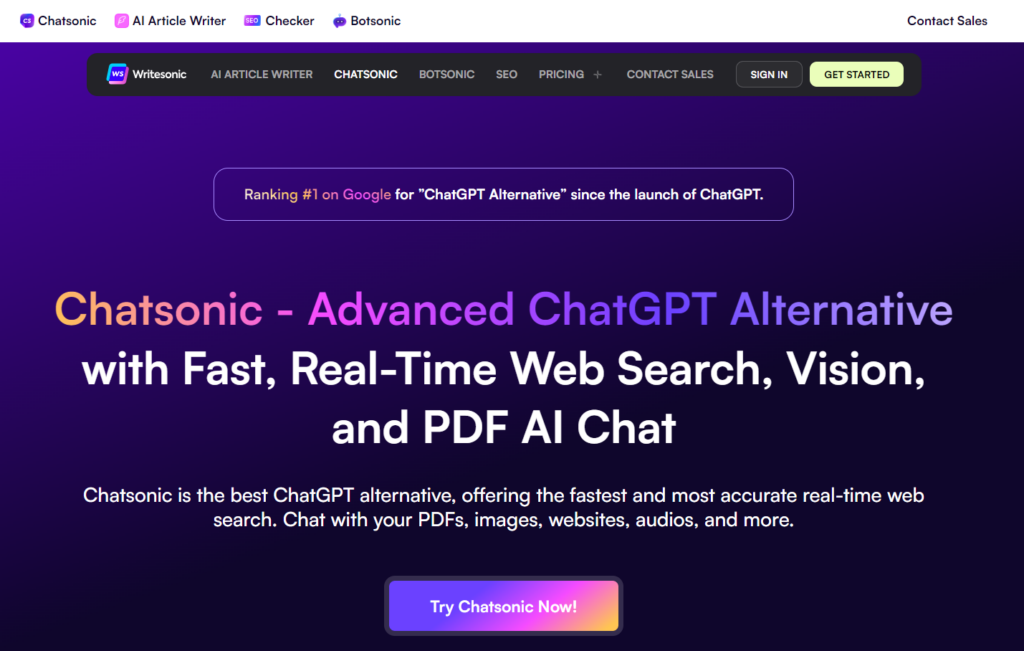
ChatSonic, brought to you by Writesonic, is a strong contender in AI chatbots and a noteworthy competitor to ChatGPT. It offers a range of features that cater to various needs, making it a versatile tool for individuals and businesses alike.
ChatSonic Key Features & Benefits
Boasting diverse functionality, here’s what makes ChatSonic shine:
- Generative and Conversational AI: ChatSonic excels at generating different creative text formats, like poems, code, scripts, musical pieces, emails, letters, etc., and engaging in human-like conversations, making it a versatile tool for various content creation and communication needs.
- Integration with Google Search: This feature sets ChatSonic apart by allowing the AI to access and process real-time information, ensuring its responses are up-to-date and relevant to current events and trends.
- Voice Command and Text-to-Speech: Interact with ChatSonic using voice commands and listen to its responses through text-to-speech functionality. This hands-free approach enhances user experience and accessibility.
- AI Image Generation: Similar to Dall-E, ChatSonic can generate realistic and creative images based on your text prompts, adding a visual dimension to your interactions with the AI.
- Personalized Avatars: Create and customize your AI chatbot persona with unique avatars, allowing for a more engaging and personalized experience.
- Mobile App Availability: ChatSonic’s dedicated mobile app allows you to access its capabilities on the go, ensuring you can utilize its features whenever and wherever you need them.
These standout features provide immense benefits, including easy record-keeping, enhanced customer interaction quality through a smart recommendation system, customized chatbot solutions as per industry requirements, and continuous improvement with its self-learning mode.
ChatSonic Use Cases
ChatSonic’s diverse feature set opens doors to a wide range of applications across various domains:
- Content Creation: Generate creative content formats like blog posts, articles, social media captions, and marketing copy.
- Customer Service: Develop AI-powered chatbots to handle customer inquiries, provide support, and offer personalized recommendations.
- Education and Research: Explore complex topics, gather information, and generate summaries of research findings.
- Personal Productivity: Use ChatSonic to brainstorm ideas, create to-do lists, and set reminders.
- Entertainment: Engage in fun and interactive conversations, generate creative stories, and explore different writing styles.
But these are just examples! Depending on your individual or organizational requirements, you can harness the power of custom-built chatbots offered by this ChatGPT similar AI differently.
ChatSonic vs ChatGPT – 3 Key differences
While both platforms provide compelling features and multiple use cases, let’s explore three areas where they vary significantly:
- Real-time Information Access: ChatSonic’s integration with Google Search enables it to provide more relevant and up-to-date responses than ChatGPT, which relies on a static dataset.
- Customizable Bots: While ChatGPT has provided highly accurate responses in various domains, the ability to create personalized bots as per specific needs with ChatSonic gives it an edge.
- Smart Recommendation versus Text Generation: While ChatGPT generates a complete text response based on prompts and previous interactions, ChatSonic takes a distinct approach by suggesting possible responses for users to choose from.
- AI Image Generation: The ability to generate images based on text prompts adds a unique dimension to ChatSonic, making it a more versatile tool for creative projects.
Claude: The Next Generation of AI Assistance
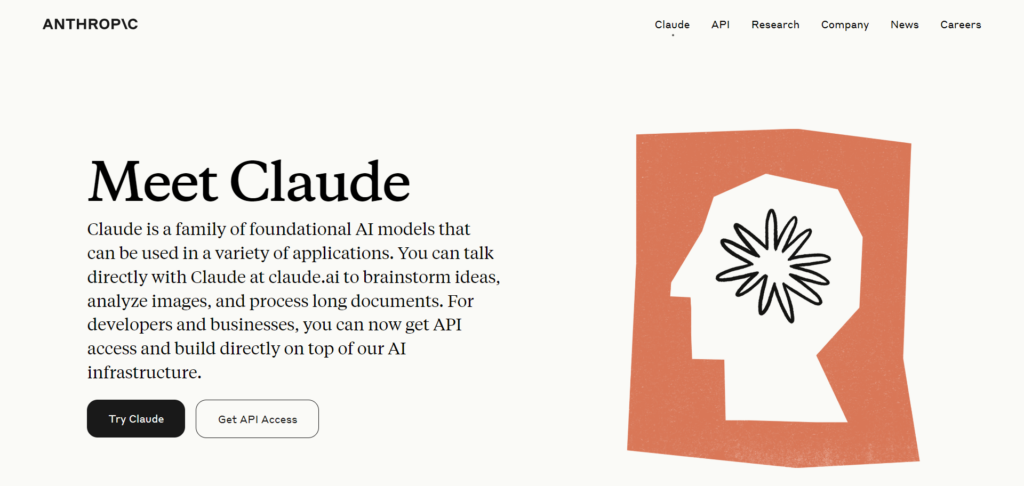
Developed by Anthropic, Claude is a large language model (LLM) that’s rapidly gaining traction as a powerful ChatGPT alternative. It’s designed to focus on safety and user-friendliness, aiming to provide reliable and harmless interactions. Let’s explore what makes Claude unique.
Claude Key Features & Benefits
As a rising star in the confluence of Natural Language Processing (NLP) and Machine Learning (ML), Claude embraces some prominent features contributing to its effectiveness as a competitive chatbot.
- Safety and Harmlessness: Claude prioritizes providing safe and harmless responses. Anthropic has implemented a unique training process emphasizing ethical considerations, making Claude less prone to generating biased or offensive content.
- Enhanced Dialogue Capabilities: Claude excels at carrying on extended conversations, remembering past interactions, and providing contextually relevant responses. This makes it ideal for scenarios where ongoing dialogue is crucial.
- Customization and Control: Claude offers users control over their responses. You can adjust parameters to influence the style and tone of the output, tailoring it to specific needs.
- Optimized ML Modules: Its machine learning modules are optimized for scalable responses depending upon user interaction patterns.
These key benefits make Claude comparable and arguably superior to other AI platforms like ChatGPT under certain use cases.
Claude Use Cases
The diversity of use cases where you could deploy Claude makes it fascinating:
- Customer support: You can implement it as customer support on your website or app. Its fluent multilanguage support adds immense value in serving customers around the globe.
- For developers willing to march forward into conversational AI implementation, Claude provides robust tools through APIs that enable seamless integration within apps or software.
- Content Creation: From drafting emails and reports to generating creative content like poems or scripts, Claude assists with various writing tasks.
- Research and Summarization: Claude can analyze complex information and provide concise summaries, aiding researchers and students in their work.
- Education and Training: Claude’s interactive nature makes it a valuable tool for educational purposes, enabling personalized learning experiences and simulations.
In dealing with these specific tasks, specialized solutions like Claude shine bright compared to generic solutions like ChatGPT!
Claude vs ChatGPT – 3 Key Differences
While both Claude and ChatGPT are powerful LLMs, they have some key distinctions:
- Safety Focus: Claude’s emphasis on safety and harmlessness sets it apart, making it a more reliable choice for applications where avoiding bias or offensive content is critical.
- Dialogue Capabilities: Claude’s ability to maintain context and engage in extended conversations gives it an edge in scenarios requiring ongoing interaction.
- Customization Options: Claude offers more control over response style and tone, allowing users to tailor the output to their preferences.
Claude has truly earned its place as a valuable competitor to ChatGPT due to these compelling strengths while managing few commonalities.jpeg
GitHub Copilot: AI-Powered Coding Assistance
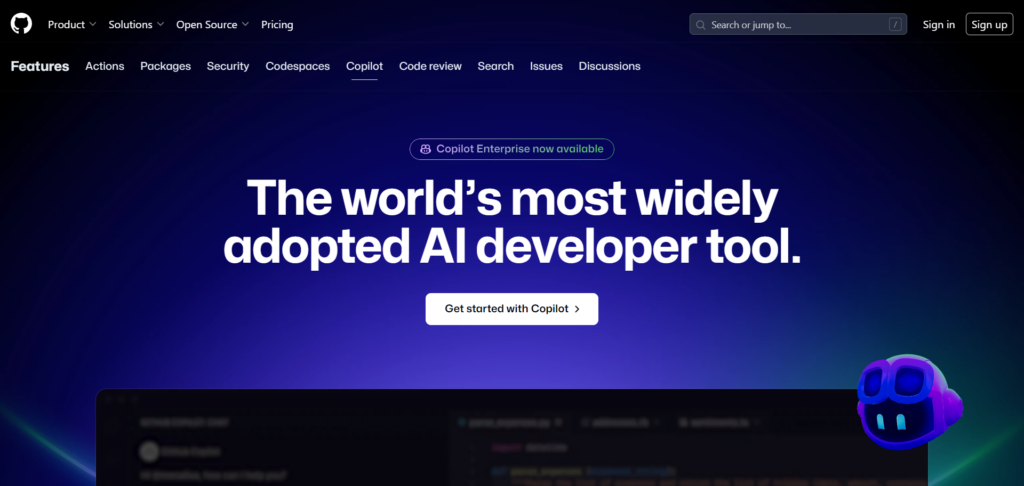
Regarding AI chatbot alternatives, Github Copilot proves a strong contender in the field. As an innovative tool by GitHub and OpenAI, it’s been designed with coders in mind and functions as an AI programming assistant. Crucially, though, how does it compare against the likes of ChatGPT?
GitHub Copilot Key Features & Benefits
GitHub Copilot goes beyond a simple text generator tool. Its specialized functions are for creating code. It helps users write code faster, smarter, and with fewer errors. Now let me point out some salient features & benefits that make this tool stand out:
- Code Suggestions: Copilot provides context-aware code suggestions directly within your code editor. Analyzing the surrounding code and comments suggests lines of code or entire functions, boosting your coding efficiency and speed.
- Learning and Adaptation: Copilot continuously learns from your coding patterns and style. This means that its suggestions become more personalized and relevant to your specific workflow over time.
- Whole line or block suggestions: This feature takes the autocomplete function to another level by suggesting entire lines or blocks of code.
- Cross-language functionality: Impressively enough, GitHub Copilot offers support for over 50 languages and frameworks.
Now that we have examined what sets GitHub Copliot apart let’s consider various situations in which it can be effectively employed.
GitHub Copilot Use Cases
The utility of GitHub Copilot cannot be understated when considering applications across a variety of scenarios:
- It can help budding developers learn new coding languages through interactive guidance rather than static tutorials.
- Existing professionals might employ it as a handy on-the-go toolkit, enabling rapid code generation.
- In project teams of individuals with diverse programming backgrounds and expertise levels, GitHub Copilot can prove quite resourceful for deciphering unfamiliar pieces of code.
Seeing these use cases gives one perspective on how versatile this program is. But I know you’re wondering: “Is Github’s offering really better than our established principle subject, ChatGPT?”
GitHub Copilot vs ChatGPT – 3 Key differences
While both have their own strengths, a few differences could potentially tip your preference to one side or the other.
- Focus: Copilot is designed explicitly for coding assistance, while ChatGPT has a broader scope, including text generation, translation, and conversation.
- Integration: Copilot seamlessly integrates with code editors, providing suggestions in real-time as you code. ChatGPT, on the other hand, typically requires input through a separate interface.
- Contextual Understanding: Copilot’s strength lies in understanding the context of code and providing relevant suggestions based on the surrounding code. ChatGPT may require more explicit instructions to generate code accurately.
Gemini: AI for Dynamic Content Creation
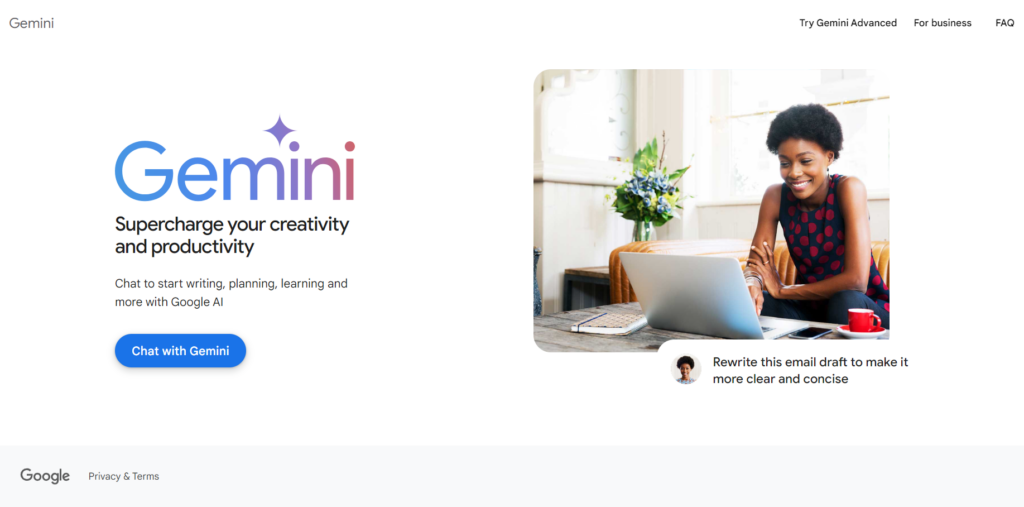
Google’s response to the rising popularity of AI chatbots like ChatGPT is Gemini (previously Bard). This powerful tool leverages Google’s vast knowledge base and cutting-edge technology to provide users with an exceptional conversational AI experience. Let’s explore the key features and benefits of Google Gemini and how it compares to ChatGPT.
Google Gemini Key Features & Benefits
Gemini stands out with key features that are designed around functional adaptability, ease of use, and a user-centric experience:
- Integrated Data: One of its unique selling points is its ability to integrate current data from various engines, such as Google Search, Google Maps, and its new Gemini backbone.
- Real-Time Results: The dynamic data integration allows Gemini to provide real-time solutions that capitalize on the most up-to-date information available on the web.
- Context-Aware Responses: With an improved understanding of context, Gemini offers nuanced responses that closely mimic human conversation.
- User-Centered Approach: Gemini allows users more control over their interaction as they can adjust settings based on their preference for formal or informal communication styles.
- Text Generation: Gemini excels at generating different creative text formats, like poems, code, scripts, musical pieces, emails, and letters. Whether you need help crafting a compelling story or writing a professional email, Gemini can assist you.
- Translation: Gemini’s translation abilities make language barriers a thing of the past. It can translate between numerous languages, making it a valuable tool for communication and understanding.
- Question Answering: Gemini’s ability to answer your questions in an informative way, even if they are open-ended, challenging, or strange, makes it a versatile tool for learning and exploration.
- Summarization: Need to quickly grasp the key points of a lengthy document or article? Gemini can generate concise summaries, saving you time and effort.
The benefits stemming from these feature highlights are far-reaching: reduction in time spent searching for accurate responses, decreased likelihood of erroneous information, and enhanced user-interactive experience.
Google Gemini Use Cases
Efficient use cases of this ingenious AI tool include:
- Streamlining Business Operations: Many businesses have effectively employed Google Gemini in customer service roles, where immediate access to the latest data is crucial for effective problem-solving.
- Content Creation & Optimization: From drafting creative content to making SEO tweaks, digital marketers can leverage the power of AI through tools like Gemini.
- Research and Education: Gemini’s ability to access and process information makes it an invaluable tool for research, answering questions, and summarizing complex topics.
- Customer Service: Businesses can utilize Gemini to create chatbots that provide instant and accurate responses to customer inquiries, enhancing customer satisfaction.
- Personal Assistance: Tasks ranging from scheduling appointments to finding nearby restaurants fall within another prevalent use-case scenario with Gemini.
Is Google Gemini Better Than ChatGPT?
Google Gemini and ChatGPT are powerful AI chatbots with unique strengths and weaknesses. Choosing the “better” option depends on your specific needs and preferences.
ChatGPT excels in creative writing and generating different text formats. At the same time, Gemini shines in providing accurate and up-to-date information through its integration with Google Search. As G2.com points out, “Alphabet’s Bard will utilize the full scope of the web to solve tasks given to it by users, using the most up-to-date data to complete tasks .”This real-time access to information gives Gemini an edge when dealing with current events or factual queries.
Ultimately, the best way to determine which AI chatbot is right for you is to explore both options and see which one aligns better with your requirements.
Jasper Chat: AI-Driven Conversational Experiences
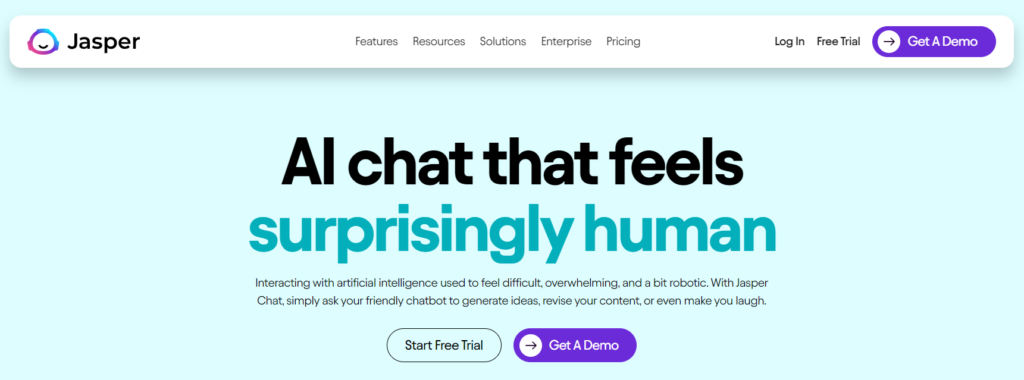
Jasper, formerly known as Jarvis, has carved its niche as a prominent AI writing tool and a compelling ChatGPT competitor. While it doesn’t position itself solely as a chatbot, its “Jasper Chat” feature offers a conversational AI experience that rivals ChatGPT in many aspects. Let’s delve into the key features, benefits, and use cases of Jasper Chat and see how it stacks up against ChatGPT.
Jasper Key Features & Benefits
Jasper shines in a few key areas where it earns praise amongst users:
- Text Completion: Similar to ChatGPT, Jasper excels at generating human-like text completions based on the input it receives.
- Advanced Algorithms: Unlike many other chatbots, Jasper utilizes sophisticated machine learning algorithms to deliver more accurate responses.
- Content Creation: In addition to conversations, Jasper can be utilized as a content creation assistant to aid in writing articles, blog posts, and social media content.
- Boss Mode: This feature unlocks Jasper’s full potential, allowing users to provide specific commands and instructions to guide the AI’s output. It’s like having a personal AI assistant who understands your exact requirements.
- Templates: Jasper offers diverse templates for different content types, from blog posts and social media captions to marketing copy and even poems. These templates provide a starting point and structure, making it easier to generate high-quality content quickly.
- Outstanding Customer Support: Perhaps one of the significant advantages over competitors is its dedicated and responsive customer support team.
Moreover, a very attractive package is available for just $49 per month, making it highly accessible to small businesses or individual users.
Jasper Chat Use Cases
The capabilities of the tool extend beyond general conversation and into practical applications, such as:
- Assisting with copywriting projects or content generation tasks, including content brainstorming, creation, research, and summarization.
- Functioning as an interactive tutor by providing detailed explanations on specific subjects,
- Offering concierge-like services by booking appointments or setting up reminders,
- Acting like a professional virtual secretary managing emails or drafting typescripts efficiently.
Backed by these features and benefits, this bot’s use cases are extensive, covering both business needs and personal tasks.
ChatGPT vs. Jasper – 3 Key differences
As powerful as ChatGPT might be, some distinct differences set Jasper apart from this competitor:
- Content Creation Focus: Jasper’s templates and features, like Boss Mode, are specifically designed for content creation. ChatGPT, on the other hand, is a more general-purpose chatbot that excels at open-ended conversations and information retrieval.
- Pricing: ChatGPT offers a free tier with limited features, while Jasper requires a paid subscription. However, Jasper’s paid plans provide access to more advanced features and higher usage limits. Jasper is one of the most popular ChatGPT alternatives, and its chatbot tool costs $49 per month.
- User Interface: Jasper provides a more structured and organized interface with its templates and recipes, while ChatGPT offers a simpler chat interface.
- Customer Support: In contrast to ChatGPT, which has occasionally been flagged for less-than-stellar client assistance, customers rave about Jasper’s support staff.
OpenAI Playground: Experimenting with AI Models
OpenAI Playground emerges as a versatile platform within AI language models, presenting a unique space for exploration and experimentation. Let’s delve into its key features, benefits, use cases, and how it stands apart from ChatGPT.
OpenAI Playground Key Features & Benefits
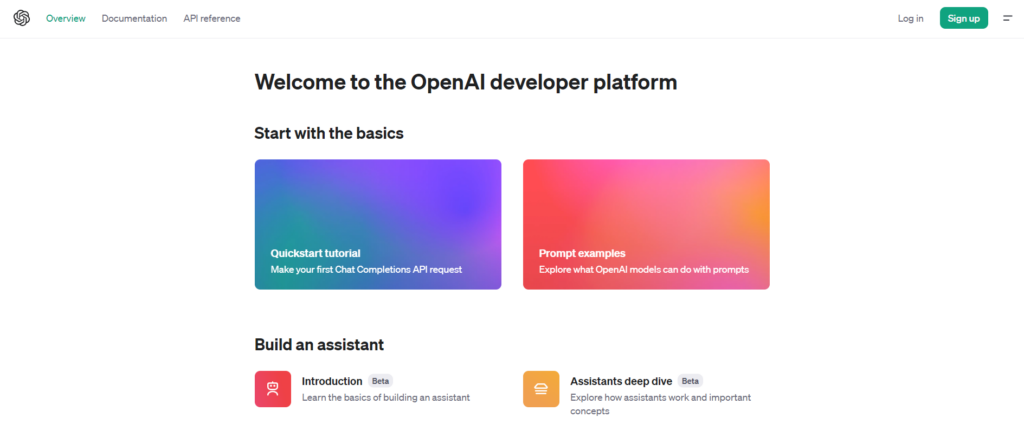
OpenAI Playground provides a sandbox environment, allowing users to interact with various OpenAI models, including GPT-3.5 and GPT-4. Its interface offers several features that enhance user experience and control. These include:
- Interactivity: The Playground provides users with an intuitive interface where they can interact in real-time with various models.
- Variety of Models: A robust range of AI models is available to explore dust-off barriers in innovation exploration.
- Parameter Adjustment: OpenAI Playground empowers users to adjust various parameters influencing the model’s output. These include temperature, which controls the creativity and randomness of the generated text, and response length, which allows for concise or elaborate responses.
- Stop Sequences: Users can define specific sequences of words or characters that, when generated, signal the model to stop producing further text. This feature provides greater control over the generation process, preventing the model from going off tangents or generating irrelevant content.
- Pre-written Prompts: The platform offers a collection of pre-written prompts to inspire users and provide starting points for their exploration. This feature is particularly helpful for those new to AI language models and can spark creative ideas.
- Safety Measures: With enhanced safety measures, experiments must be accompanied by careful considerations regarding ethical implications and potential misuse.
In essence, ease of use and extensive discovery opportunities place OpenAI Playground snugly on any list detailing top-notch ChatGPT alternatives.
OpenAI Playground Use Cases
But how exactly does all this functionality transition into practical use? Let’s dive right into some illustrative scenarios:
- Content Writers rack up significant benefits by using it for ideas generation, content optimization, and even headline suggestions.
- Programmers find value in code generation or enhancing their coding proficiency through interaction with expert-level AI models.
- Educators are not left behind either; they use the tool to explain complex concepts, create study material, or design interactive student coursework.
These test cases reveal that the applications of OpenAI’s Playground extend from professional fields to personal growth arenas.
ChatGPT vs OpenAI Playground – 3 Key Differences
Let’s discern why one might want to consider OpenAI Playground as a ChatGPT alternative. Here are three defining distinctions:
- User Interface: ChatGPT offers a simple and user-friendly chat interface, making it easy for anyone to start a conversation with the AI. OpenAI Playground, on the other hand, provides a more advanced interface with various controls and parameters, catering to users who desire greater control and customization.
- Model Access: ChatGPT primarily provides access to a single conversational AI model. OpenAI Playground allows users to explore and experiment with various OpenAI models, including GPT-3.5 and GPT-4, each offering distinct capabilities and strengths.
- Customization: ChatGPT offers limited customization options, primarily focusing on the conversational aspect. OpenAI Playground empowers users to adjust various parameters and settings, tailoring the model’s behavior and output to their needs.
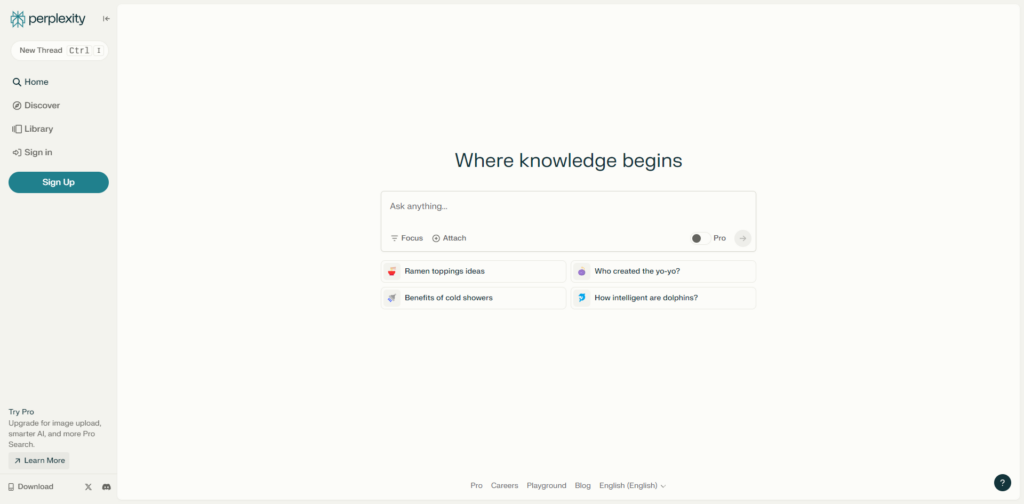
Known for its apex technology and adept algorithms, Perplexity AI provides robust AI services. Its impressive capabilities as a ChatGPT alternative have garnered attention.
Perplexity AI Key Features & Benefits
Perplexity AI unveils myriad features designed to step up your game in artificial intelligence. Here are some entrenched advantages:
- Real-time information access: Unlike ChatGPT, which has limited knowledge of events after 2021, Perplexity AI can access and process real-time information through Google Search. This makes it a valuable tool for staying current on events and accessing the latest research and data.
- Conversational search: Perplexity AI allows you to ask questions and receive answers conversationally, making it feel like you’re interacting with a knowledgeable friend.
- Citation of sources: One of Perplexity AI’s standout features is its ability to cite its information sources. This enhances transparency and allows users to verify the accuracy and credibility of the information provided.
- Summarization: Perplexity AI can summarize factual topics or create stories. This feature can be useful for quickly grasping the main points of a complex topic or generating creative content.
- Data Management Ability – Ideal for companies dealing with large volumes of data as Perplexity AI can manage diverse datasets effectively.
- User-friendly Interface: Despite being multi-functional, its user-friendly interface ensures simplicity.
To sum up these key benefits, the main allure lies in its potent capabilities combined with user convenience, which allows you to harness power-packed performance.
Perplexity AI Use Cases
While we marvel at Perplexity’s key features, let’s move into exploring some effective use cases:
- Research and education: Students and researchers can use Perplexity AI to find information on current events, explore academic topics, and get summaries of research papers.
- Businesses can leverage its capabilities to generate custom reports, thus enabling more intelligent decision-making.
- Content creators will find this tool helpful because it offers content suggestions and creative prompts based on specific topics or themes.
- Staying informed: Anyone who wants to stay up-to-date on current events and news can use Perplexity AI to get the latest information.
- The outstanding language model is handy for customer service platforms, as it seamlessly interacts with customers and accurately answers queries.
Perplexity vs ChatGPT – 3 Key Differences
Even though both Perplexity AI and ChatGPT are top runners in the AI sector, here’s a comparative analysis outlining three essential differences that set them apart:
- Real-time information: Perplexity AI can access real-time information through Google Search, while ChatGPT’s knowledge is limited to data before 2021.
- Source Citation: Perplexity AI cites its information sources, providing transparency and credibility, which ChatGPT lacks.
- Focus: ChatGPT primarily generates different creative text formats, such as poems, code, scripts, musical pieces, emails, letters, etc., while Perplexity AI provides accurate information and summaries of factual topics.
YouChat: Seamless AI Conversations
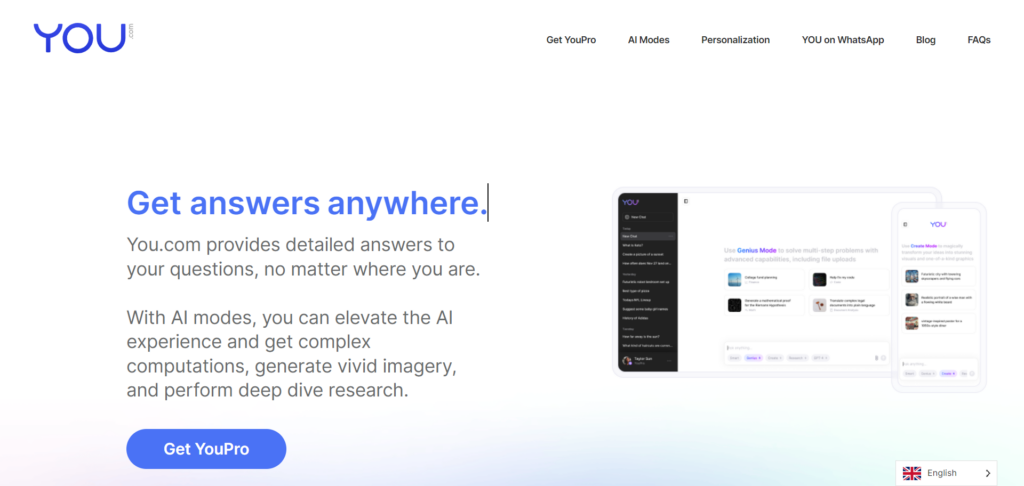
YouChat, just like the name implies, offers a user-friendly chat interface for various AI-powered tasks. While it’s a fantastic ChatGPT alternative, it sets itself apart with a unique focus on search functionality. It’s like having a conversation with a search engine!
YouChat Key Features & Benefits
YouChat boasts several features that make it a powerful tool for both casual users and professionals:
- Search-based responses: YouChat excels at providing answers based on real-time search results. Imagine asking a question and getting a response enriched with the latest information from the web – that’s the magic of YouChat.
- Conversational style: YouChat interacts conversationally, making it feel like you’re chatting with a knowledgeable friend rather than a machine.
- Code generation: Need help with coding? YouChat can generate code in multiple programming languages, making it a handy companion for developers.
- Text summarization: YouChat can efficiently summarize lengthy texts, saving time and effort when dealing with complex documents or articles.
- Accessibility and cost: YouChat is completely free to use and accessible through a web interface, so you can start exploring its capabilities right away without any financial barriers.
This makes using YouChat an enriching experience due to its lack of financial constraints and its robust performance amidst simplistic operations governed by advanced technology.
YouChat Use Cases
As far as use cases are concerned, we’ve observed multiple scenarios where YouChat excels exceptionally:
- Research and information gathering: Do you need to research a topic or find specific information quickly? YouChat’s search-powered responses can provide up-to-date insights and relevant data.
- Creative writing and content creation: Are you stuck on a writing project? YouChat can help you brainstorm ideas, generate different creative text formats, and even translate languages to overcome creative blocks.
- Learning and education: YouChat can be a valuable learning companion, assisting with homework, explaining complex concepts, and providing different perspectives on various topics.
- Coding assistance: Developers can leverage YouChat’s code generation capabilities to speed up their workflow, find code examples, and debug issues.
YouChat vs ChatGPT – 3 Key differences
Now, let’s assess how it differs from ChatGPT:
- Search Focus: YouChat’s responses are grounded in real-time search results, providing the most up-to-date information, whereas ChatGPT relies on its internal knowledge base, which may not always reflect the latest developments.
- Accessibility: YouChat is free, while ChatGPT offers free and paid plans with varying features and capabilities.
- Code Generation: YouChat provides more comprehensive code generation capabilities than ChatGPT, making it a preferred choice for developers. YouChat is a strong contender in ChatGPT-similar AI. It offers a unique blend of search and conversational AI, making it a valuable tool for various users and use cases. Looking for a ChatGPT alternative? YouChat’s free access and powerful features make it a compelling option.
Thus, YouChat emerges as an economical yet robust alternative deserving consideration when choosing your AI chatbot tool.
FAQs about ChatGPT alternatives and competitors
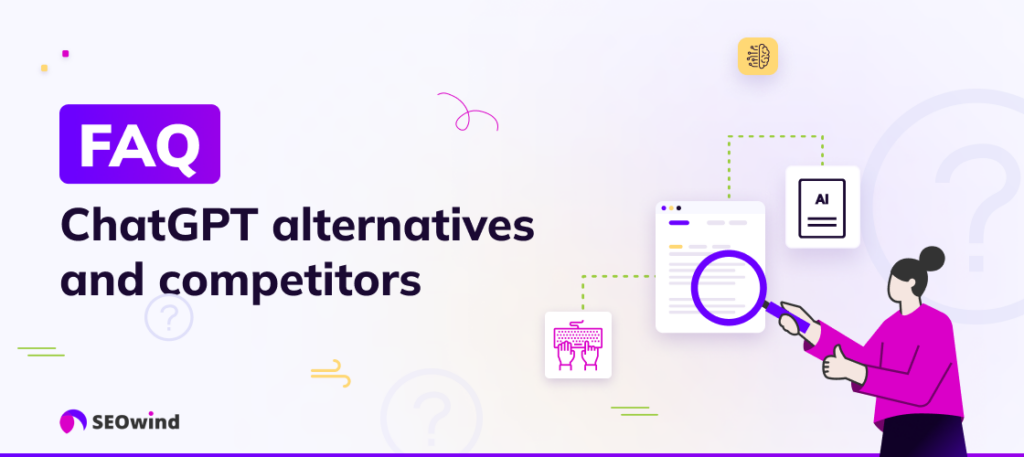
What are AI chatbots?
AI chatbots are sophisticated computer programs designed to simulate human conversation. Through methods such as Natural Language Processing (NLP) and Machine Learning, these bots comprehend and respond to complex language patterns in real-time. Highly adaptive, they’re designed for a bevy of tasks, ranging from customer service support to individual assistance like booking appointments or performing online purchases. Think of them as virtual assistants who can answer your questions, follow your instructions, and even engage in casual chit-chat.
How do AI chatbots work?
AI chatbots function by utilizing several sophisticated techniques incorporated under the broader umbrella of artificial intelligence, primarily natural language understanding (NLU), machine learning algorithms, and deep learning neural networks.
- The process initiates when a user presents a query.
- In the understanding phase, NLU comes into play, dissecting the language structure to perceive user intent.
- Next is the eval code traversed through Machine Learning algorithms to determine the optimal response.
- Lastly, the response phase includes presenting results with generated human-like text, usually exploiting some form of AI text generation algorithm.
You can visualize it as an intricate dance between request and response orchestrated by smart rules and learning algorithms behind the scenes.
What are alternatives to ChatGPT?
Several worthy competitors have emerged in recent years, posing viable ChatGPT alternatives. Some noteworthy names include:
- SEOwind: A formidable tool specially designed for generating SEO-optimized content.
- Gemini leverages Google’s vast knowledge base to provide comprehensive and informative responses.
- ChatSonic: excels at generating factual content and engaging in real-time conversations.
- Claude: Known for its high-quality language models covering over 20 languages.
- GitHub Copilot: Tailored particularly towards developers for coding assistance.
- Jasper Chat is known for its creative storytelling and marketing content generation skills.
- OpenAI Playground: Provides access to GPT-3 and other models, making it perfect for various AI applications.
- Perplexity AI: Noted particularly for its solution-oriented approach within the customer service realm
- YouChat integrates seamlessly with search engines, offering a blend of conversational AI and information retrieval.
How should you choose an AI chat tool?
Choosing the right AI chatbot might feel overwhelming, given the numerous options available today’s info-heavy world. However, considering several key aspects can ease the process drastically:
- Goals clarity: Identify what task(s) you want your bot to take over.
- Features: Do you need features like factual language generation, real-time conversation, or creative writing?
- Language quality: The bot should be able to produce fluent and contextual responses across multiple languages if needed.
- Integration capabilities: Verify whether it will sync well with your current system architecture and connect to desired services or platforms.
- Customizability: Freedom to tweak settings and modify responses according to user inputs stands crucial.
- Cost-effectiveness vs needs fulfillment: Compare how much value addition the proposed tool would bring versus its cost implications, keeping budgetary constraints in mind.
Remember, every business has unique requirements that dictate different approaches to adopting technology. Consequently, selecting an appropriate chatbot should primarily resonate with your overarching organizational goals and specific use case.
Which AI is better than ChatGPT?
To assert that one AI entity is universally ‘better’ than another can be tricky. This usually depends on the specific needs and goals a user might have. However, based on user reviews and personal experience with several services, Jasper.ai has shown promising signs. It touts remarkable versatility in content drafting, brainstorming session management, and natural language processing capabilities, which edge over ChatGPT.
In addition, tools like SEOwind bring unique strengths to the table, such as powerful algorithms for generating optimized articles or blog posts. Synthesizing these factors suggests that both Jasper.ai and SEOwind pose impressive packages that could outmatch ChatGPT depending on your individual requirements.
What are the top 10 AI websites like ChatGPT?
Chatbots have become an intrinsic part of our digital ecosystem. Here is my compiled selection of burgeoning AI websites akin to ChatGPT:
- SEOwind.ai
- Claude
- Chatsonic
- YouChat
- Perplexity AI
- OpenAI Playground
- Google Gemini
- GitHub Copilot
- Jasper.ai
These chatbots offer distinctive features, each catering uniquely to diverse objectives in different industries or projects. Remember, this list is not exhaustive, and numerous alternatives are better than ChatGPT. Exploring platforms like Perplexity AI, Claude, and OpenAI Playground can further expand your options and help you discover hidden gems in the AI landscape.
What are some of the best ChatGPT alternatives, and why?
As we’ve discussed, the “best” alternative depends on your needs. However, several ChatGPT alternatives have gained significant traction due to their unique strengths and capabilities:
- SEOwind: Ideal for those seeking SEO-optimized content creation tools.
- ChatSonic: Excels in generating factual and up-to-date content.
- Jasper Chat: A popular choice for crafting marketing copy and creative content.
- Gemini: Offers real-time access to Google Search, ensuring factual response accuracy.
- GitHub Copilot: Specifically designed to assist developers with code generation and completion.
These are just a few examples. The best way to determine the ideal ChatGPT alternative is to explore and experiment with different options. When making your decision, consider your specific needs, desired features, and budget.


